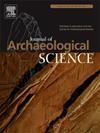尼姆鲁德的新亚述书写板的材料特征
IF 2.6
1区 地球科学
Q1 ANTHROPOLOGY
引用次数: 0
摘要
尼姆鲁德(今伊拉克)出土的书写板是在蜡上书写楔形文字的第一批物证。20 世纪 50 年代进行的科学调查发现,淡黄色的书写膏是蜂蜡和雌黄(As2S3)的混合物,书写板可能由胡桃木(Juglans regia)制成。分析技术的进步和对书写板的进一步考古发现重新激发了人们对这些文物及其材质的兴趣。本研究采用傅立叶变换红外光谱法 (FTIR)、原位硅烷化热解-气相色谱-质谱法 (Py(HMDS)-GC-MS) 和气相色谱-四极杆飞行时间质谱法 (GC-QToF-MS),对大英博物馆收藏的一些书写板碎片进行了重新检测,以确定蜡浆有机成分的特征。拉曼光谱和扫描电子显微镜分别用于颜料和木材种类的鉴定。结果证实,黄色蜡膏是由蜂蜡和雌黄混合而成。蜡成分保存得特别好,没有检测到有机添加剂。GC-QToF-MS 甚至在木板上没有蜡的直观痕迹的地方也检测到了蜡的痕迹。烧焦的植物物质与碳黑颜料的使用一致,这表明中东地区也生产灰黑色的书写板,这种颜色在希腊和罗马的做法中比较常见。经证实,这种木材是胡桃木,原产于西南亚。由于迄今为止还没有发现古代近东蜡制书写板的配方,因此收集到的信息对于更好地了解这种古老的做法、将这一知识建立在科学证据的基础上以及加强中东和其他地区木制书写板的背景研究至关重要。本文章由计算机程序翻译,如有差异,请以英文原文为准。
Material characterisation of the Neo-Assyrian writing boards from Nimrud
The writing boards excavated from Nimrud (modern Iraq) represent the first material evidence of cuneiform writing on wax. Scientific investigations conducted in the 1950s identified the yellowish writing paste as a mixture of beeswax and orpiment (As2S3), with the boards possibly made from walnut (Juglans regia). Advances in analytical techniques and further archaeological discoveries of writing boards have renewed interest in these artifacts and their materiality. This study re-examines some board fragments in the British Museum using Fourier Transform infrared spectroscopy (FTIR), pyrolysis-gas chromatography-mass spectrometry with in situ silylation (Py(HMDS)-GC-MS) and gas chromatography coupled to quadrupole time-of-flight mass spectrometry (GC-QToF-MS) for the characterisation of the organic components of the wax paste. Raman spectroscopy and scanning electron microscopy (SEM) were used for pigment and wood species identification, respectively. The results confirmed that the yellow paste is composed of beeswax mixed with orpiment. The wax components are particularly well preserved, and no organic additives were detected. GC-QToF-MS detected traces of wax even from areas of the boards where no visual evidence of wax survived. Charred vegetable matter, consistent with the use of a carbon black pigment, suggests that writing boards with a grey/black colour, relatively common in Greek and Roman practices, were also produced in the Middle East. The wood was confirmed to be walnut, which is native to Southwest Asia. As no ancient Near Eastern recipe for wax writing boards has come to light so far, the information gathered is key to better understand this ancient practice, ground this knowledge in scientific evidence and enhance the contextualisation of wooden writing boards in the Middle East and beyond.
求助全文
通过发布文献求助,成功后即可免费获取论文全文。
去求助
来源期刊

Journal of Archaeological Science
地学-地球科学综合
CiteScore
6.10
自引率
7.10%
发文量
112
审稿时长
49 days
期刊介绍:
The Journal of Archaeological Science is aimed at archaeologists and scientists with particular interests in advancing the development and application of scientific techniques and methodologies to all areas of archaeology. This established monthly journal publishes focus articles, original research papers and major review articles, of wide archaeological significance. The journal provides an international forum for archaeologists and scientists from widely different scientific backgrounds who share a common interest in developing and applying scientific methods to inform major debates through improving the quality and reliability of scientific information derived from archaeological research.
 求助内容:
求助内容: 应助结果提醒方式:
应助结果提醒方式:


